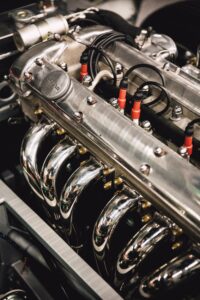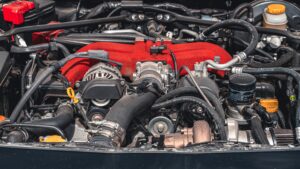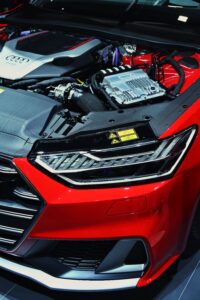
As a disclaimer there are a lot of cases of injury and burns from mishandling and accidents with the cooling system when inspecting, repairing or topping off fluid always make sure the cooling system is not hot to prevent burns from steam and boiling coolant and when the vehicle is overheating and smoking avoid opening the hood until cooled.
Whether you don’t know where coolant goes, what it is or if you check and top off the coolant yourself there is a lot to know, you can use water in an emergency but for the most part the days of filling the radiator with water and stuffing potatoes in it, is outdated. Today we have different coolants for all vehicles and climates. Keep reading to learn more about your car’s cooling system.
How Car Cooling Systems Work
Cars have three main types of coolants, Inorganic Acid Formula (IAT) which is the most well known coolant, it is the green dyed coolant for most domestic cars now and most manufacturer’s before the 2000’s. You also have Organic Acid Technology (Oat) which is dyed orange, red, yellow, dark blue, dark green. Used mostly with newer GM Vehicles after 1995 and before the early 2000’s in most European and Japanese vehicles. The last one is Hybrid Organic Acid Technology (Hoat) also known as Glowbal and is typically dyed orange, yellow, purple, pink or blue used in most European and Japanese vehicles made after the early 2000’s.
What Causes a Car Cooling System to Overheat?
All three contain different supplemental coolant additives for different anti-corrosive properties and can typically be any color that it is dyed with. Which makes it very important to read the labels of the coolant going into the system and what is already in there from the manufacturer. Mixing these together can cause significant damage to the coolant and cooling system by mixing the chemicals in each of them. This can cause chemical reactions that will turn the new coolant you filled it with either highly corrosive, acidic or even causing it to turn into a sludge depending on the mixture and the amount. So just by mixing the incorrect coolant together we can cause blockages and overheating that would require new components or a flush or create a chemical compound that could eat away at components from the inside out causing damage and needing components replaced.
Should You Use Water to Flush Coolant?
So if all these issues can be caused by coolant why not just use water and avoid it all completely together and cause no damage. The answer to that is because we need the chemical structure of it to lower the freezing point in cold climate conditions lower than 32 degrees Fahrenheit and in hotter climates above 212 Fahrenheit so with how hot the engine gets just by running as well as the cold climate conditions we need coolant no matter where we are. But with the chemical structures in all of these coolants they have a life span on how long they will last so they make a mileage and age recommendation on when to replace the coolant and flush itself however the coolant changes within its own conditions and at that point needs to be tested regularly during oil changes versus just based on mileage because it can change. You may have to visit a vehicle specialist in order to test the coolant but you still have the ability to check its level for being low, or for any leaks or drips that may be present and need to be addressed at repair facility but you can still maintain the level until then to prevent damage to the system further and prevent damage to the engine.
Blockage in Car Cooling System
Coolant itself can damage the system so when checking it look for any signs of debris, contamination or damage to the coolant fill cap seal that you can see without the use of the test strips. Another thing you can check is your coolant hoses when the vehicle is cold and has been sitting for at least eight hours. After that the system should be cold enough to touch. From there you can squeeze the hoses as the bends, you will be looking for any excessive pressure in the system there should be little to none of a cold system. You will also be checking to see if the hose feels hard and brittle on the inside or the exterior of the hose that can cause cracks that would leak fluid without pressure or open to allow for a bigger leak under pressure. The last thing is if the hose is excessively soft indicating a thinning of the rubber and a possible spot for it to bulge under pressure and blow and checking around the ends where a clamp or hose could be leaking.
Car Cooling System Leaks

Combustion Chamber Car Cooling System Issues
Another important aspect of the cooling system is being able to flow coolant properly that way as the coolant absorbs the heat of the engine and combustion chamber it is able to flow to a different area to dissipate the heat and prevent the heat from becoming trapped and causing damage. As the system flows the radiator has a lot of small passages that coolant flows through and fins connecting to the outside of the passages causing for a bigger area for air to cool as it passes through. This cools the fluid in the radiator so that cool fluid runs back to the engine to absorb heat and cool it down as old fluid re-enters the radiator to be cooled again. The radiator plays a big role in cooling the coolant which it is crucial to make sure besides checking it for leaks at the passages and the tanks but also to make sure that the fins of the radiator look undamaged and not plugged with debris that could be restricting air flow from cooling the radiator. If by appearance the radiator is physically fine on the outside and still overheating there could be an issue with the flow of the coolant either due to a clogged radiator, stuck thermostat, or failed water pump.
Thermostat and Water Pump Cooling System Parts
The thermostat and water pump have components that work internally to the cooling system that cause it to be difficult to see a physical failure without draining the system and removing the component to inspect it but prior to that you will want to make that the data you can collect from the vehicle prior to opening the system has been checked. The Water Pump is used in the cooling system to flow coolant through the passages of the engine block and cylinder head through hoses and back through the radiator and through the thermostat, without the water pump operating the coolant the system is stagnant and can become heat soaked. You can check the water pump if on your vehicle it is external to see if it has what it needs to flow coolant the first thing is to make sure the system has coolant, after that check and see if the serpentine belt that drivers it is still there and with the engine running that the belt is able to rotate on it easily, if it is there and rotated listen to the front of the engine and see if you can hear squealing coming from the belt or even a screeching that sounds like metal on metal is making contact internally if there is slippage and the belt is squealing then the water pump is not able to spin at the correct speed with the resistance of the coolant and in turn will not flow coolant correctly to dissipate. If you can hear squeaking of metal on metal there is most likely damage to the water pump fins caused by the bearing in the water pump causing the impellers significant movement allowing it to contact the inside of the housing and needs to be replaced.
Failing Thermostat on a Car
The thermostat unfortunately cannot be checked visually without removing and makes no noise typically when it fails causing it to be very difficult to diagnose unless it’s leaking externally. This component usually fails by being stuck open but even though it is designed to fail that way still doesn’t always fail stuck open there are instances of it getting stuck shut. Manufacturers typically design thermostats to fail and still allow full so that the vehicle doesn’t overheat but this does cause it to take much longer for the engine to get to operating temperature and in the winter for the heater to work.
If this component fails then it stops all flow even though the water pump is still operating it causes a blockage and the coolant to become stagnant and the vehicle to overheat.
Keeping Your Car’s Cooling System Working
The cooling system is a very detrimental system to the operation of the vehicle and maintaining it from getting too hot and damaging components. Even though it is an easy system to understand, diagnosing and repairing can prove to be difficult and every manufactured car is different in some way. And even though indirectly the only way they connect is coolant it can still cause just as many problems as it prevents if it is not serviced appropriately and is left neglected. A regular maintenance schedule with it should be followed from the owners manual for the car or even speaking with a repair specialist for a custom maintenance schedule for your specific vehicle and needs.
What Can I Do to Help My Car’s Cooling System?
Taking care of your car’s cooling system is essential to ensure your vehicle runs smoothly and doesn’t overheat. Here are some tips to help you maintain your car’s cooling system:
- Regularly check the coolant level: The coolant (antifreeze) is a vital component of your car’s cooling system. Make sure the coolant level is within the recommended range when the engine is cold. If it’s low, add a 50/50 mix of coolant and water to the reservoir.
- Inspect for leaks: Look for any signs of coolant leaks under your vehicle, such as puddles or stains on the ground. If you notice a leak, have it repaired promptly, as a coolant leak can lead to overheating.
- Replace the coolant: Over time, coolant can become contaminated or lose its effectiveness. Follow your manufacturer’s recommendations for when to replace the coolant, typically every 2 to 5 years. Use the correct type of coolant for your vehicle.
- Check the radiator cap: The radiator cap maintains pressure in the cooling system. Ensure it’s in good condition and holds the correct pressure. A faulty cap can cause overheating.
- Clean the radiator and condenser: Dirt and debris can accumulate on the radiator and condenser, reducing their efficiency. Regularly clean them with a soft brush or compressed air to ensure proper airflow.
- Inspect the cooling fans: Cooling fans help dissipate heat when your vehicle is stationary or moving slowly. Make sure they are functioning correctly. If they’re not, have them repaired or replaced.
- Check the thermostat: The thermostat regulates the flow of coolant through the engine. If it fails, it can cause the engine to overheat. Replace it if you notice temperature fluctuations or if your engine consistently runs hot.
- Flush the cooling system: Periodically flush the cooling system to remove built-up rust, scale, and other deposits. Follow your manufacturer’s recommendations for the frequency of this maintenance task.
- Maintain the water pump: The water pump circulates coolant through the engine and radiator. If it fails, your engine can overheat. Check for leaks around the water pump and replace it if necessary.
- Inspect hoses and belts: Check radiator hoses and drive belts for signs of wear and cracks. Replace any worn or damaged components to prevent coolant leaks or engine damage.
- Monitor the temperature gauge: Pay attention to your vehicle’s temperature gauge while driving. If it starts to approach the red zone, pull over safely and turn off the engine to prevent overheating. Seek professional assistance if necessary.
- Avoid heavy loads and aggressive driving: Overworking your engine can generate excess heat. Avoid towing heavy loads beyond your vehicle’s capacity and practice smooth, gradual driving to minimize stress on the engine.
Regular maintenance and timely repairs are crucial for the longevity and performance of your car’s cooling system. If you’re unsure about any aspect of cooling system maintenance, call our Bountiful auto repair team today for help!

